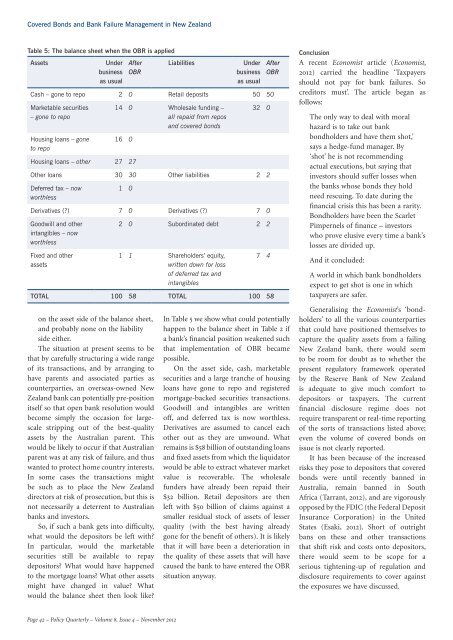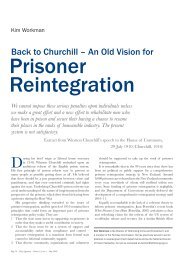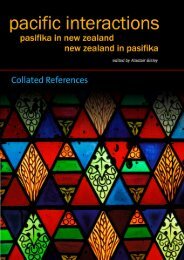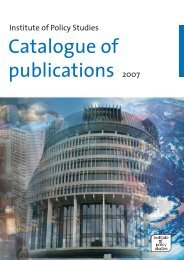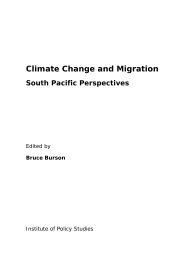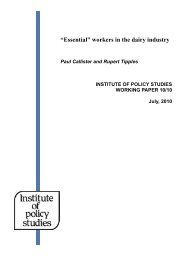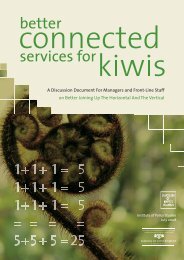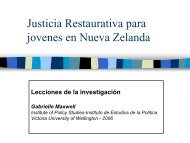PDF File - Institute for Governance and Policy Studies - Victoria ...
PDF File - Institute for Governance and Policy Studies - Victoria ...
PDF File - Institute for Governance and Policy Studies - Victoria ...
You also want an ePaper? Increase the reach of your titles
YUMPU automatically turns print PDFs into web optimized ePapers that Google loves.
Covered Bonds <strong>and</strong> Bank Failure Management in New Zeal<strong>and</strong><br />
Table 5: The balance sheet when the OBR is applied<br />
Assets<br />
Under<br />
business<br />
as usual<br />
After<br />
OBR<br />
on the asset side of the balance sheet,<br />
<strong>and</strong> probably none on the liability<br />
side either.<br />
The situation at present seems to be<br />
that by carefully structuring a wide range<br />
of its transactions, <strong>and</strong> by arranging to<br />
have parents <strong>and</strong> associated parties as<br />
counterparties, an overseas-owned New<br />
Zeal<strong>and</strong> bank can potentially pre-position<br />
itself so that open bank resolution would<br />
become simply the occasion <strong>for</strong> largescale<br />
stripping out of the best-quality<br />
assets by the Australian parent. This<br />
would be likely to occur if that Australian<br />
parent was at any risk of failure, <strong>and</strong> thus<br />
wanted to protect home country interests.<br />
In some cases the transactions might<br />
be such as to place the New Zeal<strong>and</strong><br />
directors at risk of prosecution, but this is<br />
not necessarily a deterrent to Australian<br />
banks <strong>and</strong> investors.<br />
So, if such a bank gets into difficulty,<br />
what would the depositors be left with<br />
In particular, would the marketable<br />
securities still be available to repay<br />
depositors What would have happened<br />
to the mortgage loans What other assets<br />
might have changed in value What<br />
would the balance sheet then look like<br />
Liabilities<br />
Under<br />
business<br />
as usual<br />
Cash – gone to repo 2 0 Retail deposits 50 50<br />
Marketable securities<br />
– gone to repo<br />
Housing loans – gone<br />
to repo<br />
14 0 Wholesale funding –<br />
all repaid from repos<br />
<strong>and</strong> covered bonds<br />
16 0<br />
Housing loans – other 27 27<br />
32 0<br />
Other loans 30 30 Other liabilities 2 2<br />
Deferred tax – now<br />
worthless<br />
1 0<br />
Derivatives () 7 0 Derivatives () 7 0<br />
Goodwill <strong>and</strong> other<br />
intangibles – now<br />
worthless<br />
Fixed <strong>and</strong> other<br />
assets<br />
2 0 Subordinated debt 2 2<br />
1 1 Shareholders’ equity,<br />
written down <strong>for</strong> loss<br />
of deferred tax <strong>and</strong><br />
intangibles<br />
7 4<br />
TOTAL 100 58 TOTAL 100 58<br />
After<br />
OBR<br />
In Table 5 we show what could potentially<br />
happen to the balance sheet in Table 2 if<br />
a bank’s financial position weakened such<br />
that implementation of OBR became<br />
possible.<br />
On the asset side, cash, marketable<br />
securities <strong>and</strong> a large tranche of housing<br />
loans have gone to repo <strong>and</strong> registered<br />
mortgage-backed securities transactions.<br />
Goodwill <strong>and</strong> intangibles are written<br />
off, <strong>and</strong> deferred tax is now worthless.<br />
Derivatives are assumed to cancel each<br />
other out as they are unwound. What<br />
remains is $58 billion of outst<strong>and</strong>ing loans<br />
<strong>and</strong> fixed assets from which the liquidator<br />
would be able to extract whatever market<br />
value is recoverable. The wholesale<br />
funders have already been repaid their<br />
$32 billion. Retail depositors are then<br />
left with $50 billion of claims against a<br />
smaller residual stock of assets of lesser<br />
quality (with the best having already<br />
gone <strong>for</strong> the benefit of others). It is likely<br />
that it will have been a deterioration in<br />
the quality of these assets that will have<br />
caused the bank to have entered the OBR<br />
situation anyway.<br />
Conclusion<br />
A recent Economist article (Economist,<br />
2012) carried the headline ‘Taxpayers<br />
should not pay <strong>for</strong> bank failures. So<br />
creditors must’. The article began as<br />
follows:<br />
The only way to deal with moral<br />
hazard is to take out bank<br />
bondholders <strong>and</strong> have them shot,’<br />
says a hedge-fund manager. By<br />
‘shot’ he is not recommending<br />
actual executions, but saying that<br />
investors should suffer losses when<br />
the banks whose bonds they hold<br />
need rescuing. To date during the<br />
financial crisis this has been a rarity.<br />
Bondholders have been the Scarlet<br />
Pimpernels of finance – investors<br />
who prove elusive every time a bank’s<br />
losses are divided up.<br />
And it concluded:<br />
A world in which bank bondholders<br />
expect to get shot is one in which<br />
taxpayers are safer.<br />
Generalising the Economist’s ‘bondholders’<br />
to all the various counterparties<br />
that could have positioned themselves to<br />
capture the quality assets from a failing<br />
New Zeal<strong>and</strong> bank, there would seem<br />
to be room <strong>for</strong> doubt as to whether the<br />
present regulatory framework operated<br />
by the Reserve Bank of New Zeal<strong>and</strong><br />
is adequate to give much com<strong>for</strong>t to<br />
depositors or taxpayers. The current<br />
financial disclosure regime does not<br />
require transparent or real-time reporting<br />
of the sorts of transactions listed above;<br />
even the volume of covered bonds on<br />
issue is not clearly reported.<br />
It has been because of the increased<br />
risks they pose to depositors that covered<br />
bonds were until recently banned in<br />
Australia, remain banned in South<br />
Africa (Tarrant, 2012), <strong>and</strong> are vigorously<br />
opposed by the FDIC (the Federal Deposit<br />
Insurance Corporation) in the United<br />
States (Esaki, 2012). Short of outright<br />
bans on these <strong>and</strong> other transactions<br />
that shift risk <strong>and</strong> costs onto depositors,<br />
there would seem to be scope <strong>for</strong> a<br />
serious tightening-up of regulation <strong>and</strong><br />
disclosure requirements to cover against<br />
the exposures we have discussed.<br />
Page 42 – <strong>Policy</strong> Quarterly – Volume 8, Issue 4 – November 2012


